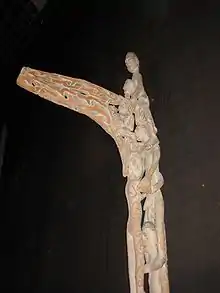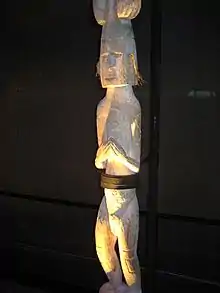Bisj pole
A Bisj or Bis pole is a ritual artifact created and used by the Asmat people of south-western New Guinea. Bisj poles can be erected as an act of revenge, to pay homage to the ancestors, to calm the spirits of the deceased and to bring harmony and spiritual strength to the community.


Objects similar to Bisj poles are found among many peoples of the South Pacific islands, such as peoples from New Zealand and Vanuatu.
Design
Carved out of a single piece of a wild mangrove[1] tree, Bisj poles can reach heights of up to 25 feet (7.62 m). Their carvings depict human figures standing on top of each other, as well as animal figures, phallic symbols, and carvings in the shape of a canoe prow.
Purpose
Bisj poles are carved by Asmat religious carvers (wow-ipits) after a member of their tribe or community had been killed and headhunted by an enemy tribe. The Asmat participated in headhunting raids and cannibalism as rituals.
The Asmat believed that if a member of the community had been headhunted, his spirit would linger in the village and cause disharmony. Bisj poles were erected in order to satisfy these spirits and send them to the afterlife (Safan) across the sea.
Many rituals involved the Bisj poles, including dancing, masquerading, singing and headhunting—all performed by men. Bisj poles often had a receptacle at the base that was meant to hold the heads of enemies taken on headhunting missions.
The phallic symbols represented the strength and virility of the community's ancestors as well as of the warriors going on the headhunting mission. Canoe prow symbols represented a metaphorical boat that would take the deceased spirits away to the afterlife. The human figures would represent deceased ancestors.
Although headhunting ended in the Asmat region in the 1970s, the poles are still used in rituals today.
Further reading
- Van der Zee, Pauline, Etsjopok: Avenging the Ancestors. The Asmat Bisj Poles and a Proposal for a Morphological Method. Working Papers in Ethnic Art 8 (University of Ghent, Department of Ethnic Art). Ghent, 1996.
- Van der Zee, Pauline, Bisj-poles: Sculptures from the Rain Forest. Amsterdam: KIT Publishers, 2007. ISBN 978-90-6832-478-5
- Caglayan, Emily. “The Asmat.” In Heilbrunn Timeline of Art History. New York: The Metropolitan Museum of Art, 2000–"
See also
References
| Wikimedia Commons has media related to Bisj poles. |